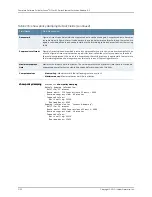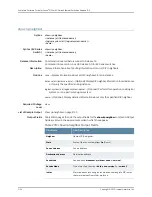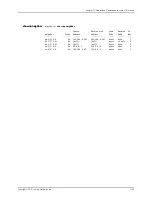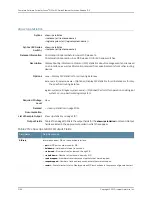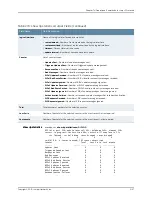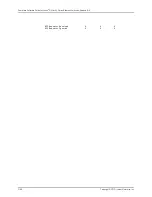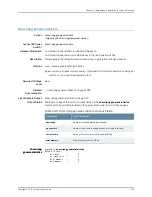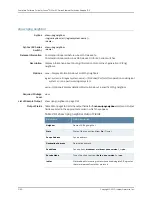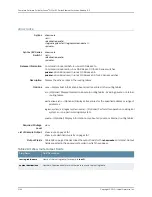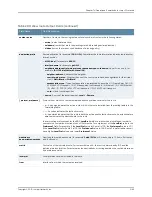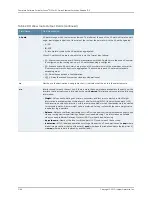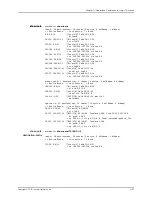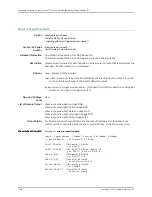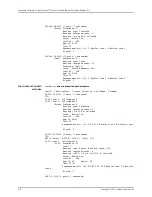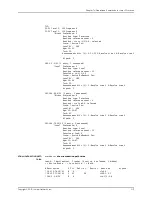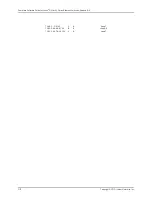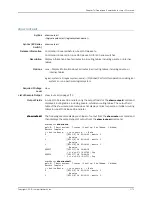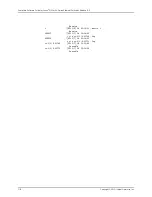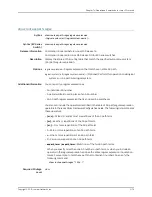
Table 283: show route Output Fields
(continued)
Field Description
Field Name
AS path through which the route was learned. The letters at the end of the AS path indicate the path
origin, providing an indication of the state of the route at the point at which the AS path originated:
•
I
—IGP.
•
E
—EGP.
•
?
—Incomplete; typically, the AS path was aggregated.
When AS path numbers are included in the route, the format is as follows:
•
[ ]
—Brackets enclose the local AS number associated with the AS path if more than one AS number
is configured on the routing device, or if AS path prepending is configured.
•
{ }
—Braces enclose AS sets, which are groups of AS numbers in which the order does not matter.
A set commonly results from route aggregation. The numbers in each AS set are displayed in
ascending order.
•
( )
—Parentheses enclose a confederation.
•
( [ ] )
—Parentheses and brackets enclose a confederation set.
AS path
Next hop to the destination. An angle bracket (>) indicates that the route is the selected route.
to
Interface used to reach the next hop. If there is more than one interface available to the next hop, the
interface that is actually used is followed by the word
Selected
. This field can also contain the following
information:
•
Weight
—Value used to distinguish primary, secondary, and fast reroute backup routes. Weight
information is available when Multiprotocol Label Switching (MPLS) label-switched path (LSP)
link protection, node-link protection, or fast reroute is enabled, or when the standby state is enabled
for secondary paths. A lower weight value is preferred. Among routes with the same weight value,
load balancing is possible.
•
Balance
—Balance coefficient indicating how traffic of unequal cost is distributed among next hops
when a routing device is performing unequal-cost load balancing. This information is available
when you enable Border Gateway Protocol (BGP) multipath load balancing.
•
lsp-path-name
—Name of the label-switched path (LSP) used to reach the next hop.
•
label-action
—MPLS label and operation occurring at the next hop. The operation can be
pop
(where
a label is removed from the top of the stack),
push
(where another label is added to the label stack),
or
swap
(where a label is replaced by another label).
via
Copyright © 2010, Juniper Networks, Inc.
2166
Complete Software Guide for Junos
®
OS for EX Series Ethernet Switches, Release 10.3
Summary of Contents for JUNOS OS 10.3 - SOFTWARE
Page 325: ...CHAPTER 17 Operational Mode Commands for System Setup 229 Copyright 2010 Juniper Networks Inc ...
Page 1323: ...CHAPTER 56 Operational Mode Commands for Interfaces 1227 Copyright 2010 Juniper Networks Inc ...
Page 2841: ...CHAPTER 86 Operational Commands for 802 1X 2745 Copyright 2010 Juniper Networks Inc ...
Page 3367: ...CHAPTER 113 Operational Mode Commands for CoS 3271 Copyright 2010 Juniper Networks Inc ...
Page 3435: ...CHAPTER 120 Operational Mode Commands for PoE 3339 Copyright 2010 Juniper Networks Inc ...
Page 3529: ...CHAPTER 126 Operational Mode Commands for MPLS 3433 Copyright 2010 Juniper Networks Inc ...

